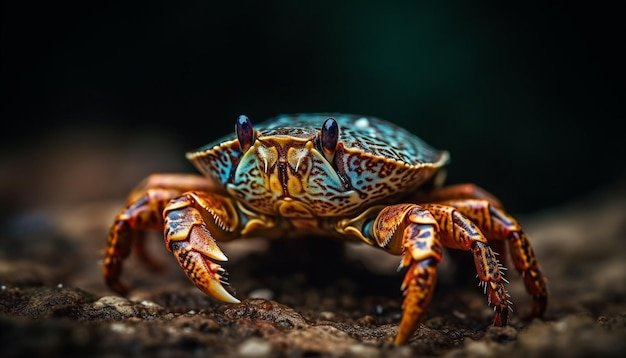
Now, just like the story of the sea, the tale of crabs is filled with ups and downs. Populations of certain species are dwindling, while others are still thriving. The world of conservation is complex—a bit like trying to untangle a fishing line on a windy day. So, what’s the scoop on crab populations? That’s what we’re here to explore!
The Importance of Crabs in Marine Ecosystems
Crabs might be small, but their impact on the ocean is massive. These creatures are scavengers, helping to break down and recycle nutrients back into the ecosystem. This process is vital because it keeps the marine food web healthy. When you think about it, crabs are like the cleanup crew of the ocean!
Besides that, crabs serve as a crucial food source for many larger animals. Fish, birds, and even humans rely on them. If crab populations start to decline, it could lead to a domino effect, disrupting the delicate balance in marine ecosystems. Honestly, without crabs, the ocean’s health could be at risk, which is something we should all care about.
Different Species, Different Challenges
Not all crabs are created equal, and the challenges they face can vary widely. For instance, the blue crab, commonly found along the Atlantic coast, faces overfishing and habitat loss. Meanwhile, the famous Dungeness crab is threatened by climate change, which affects water temperatures and habitat stability.
Here’s the thing: each species has unique needs and threats. Therefore, conservation efforts need to be specific rather than one-size-fits-all. Otherwise, we risk missing out on the bigger picture regarding crab conservation.
Current Status of Crab Populations
As of now, the International Union for Conservation of Nature (IUCN) lists several crab species as endangered or vulnerable. This means they meet certain criteria indicating they could become extinct if protective measures aren’t taken. Species like the Spider Crab and the Yeti Crab fall into this category, reminding us that even the most peculiar creatures need our attention.
In contrast, other species, like the Atlantic Rock Crab, seem to be doing well, often bouncing back thanks to effective management practices. The key takeaway? Not all crabs are endangered, but awareness and action are crucial for those that are.
Indicators of Decline
There are several indicators that suggest a crab species might be in trouble. Scientists often look at population numbers, breeding success, and habitat quality. For example, if researchers notice fewer crabs or a decline in breeding rates, that’s a red flag. Additionally, factors like pollution, habitat destruction, and climate change can further threaten these creatures.
You might be wondering how these issues connect. Crabs need clean, healthy habitats to thrive. When their homes are disturbed, it’s not just the crabs that suffer—entire ecosystems can be affected.
Conservation Efforts and Strategies
So, what are we doing about it? Various organizations and governments are stepping up to the plate to protect crab populations. Some strategies include creating marine protected areas, implementing fishing regulations, and promoting sustainable practices.
For example, fishing quotas are sets limits on how many crabs can be caught each season. This helps ensure that populations do not decline too rapidly. Additionally, educational programs aim to raise awareness about the importance of crabs and how our actions impact their survival.
Ultimately, conservation is a team effort. It’s not just up to scientists and policymakers; we all have a role to play in protecting these remarkable creatures.
Community Involvement
Local communities often play a vital role in conservation efforts. Many coastal towns depend on crabbing for their livelihoods. By engaging these communities, we can promote sustainable practices that benefit both the economy and the environment.
Events like beach clean-ups not only help the natural habitat but also foster a sense of stewardship among residents. Plus, when people make connections between their local environment and crab populations, it creates a ripple effect, encouraging further action.
What You Can Do to Help Crabs
You don’t have to be a scientist to make a difference! Here are a few simple ways you can help crabs and support their conservation:
- Practice Sustainable Seafood Choices: If you enjoy eating crab, choose sustainably sourced options. Research local fisheries and support those that prioritize healthy practices.
- Participate in Clean-Up Events: Join community clean-ups to help remove trash from beaches and waterways. This protects crab habitats from pollution.
- Spread Awareness: Share what you’ve learned about crab conservation with friends and family. Awareness is the first step toward action!
- Support Marine Conservation Organizations: Consider donating to or volunteering with groups focused on marine conservation. Your time and resources can make a real difference!
Taking these steps not only helps individual crab populations but also contributes to a healthier ocean overall.
The Future of Crabs: Hope on the Horizon
While the situation for crabs can seem daunting, there’s room for optimism. With proper management, conservation efforts show promise. Many species are starting to recover, signaling that when we take action, it can lead to positive changes.
For example, collaborative efforts between researchers and fishermen have proven fruitful in some areas, helping to rebuild crab populations. Plus, the growing interest in sustainable practices means more people are aware of their impact on marine life.
You might find it uplifting to know that conservation can work. With dedication, cooperation, and continued awareness, we can help ensure that crabs continue to scuttle along our shores for generations to come.
In conclusion, understanding the challenges facing crabs is just the beginning. By staying informed and engaged, we can contribute to the ongoing efforts to protect these remarkable creatures. Let’s keep the conversation going and work together for a future where crabs aren’t just surviving, but thriving in our oceans!
